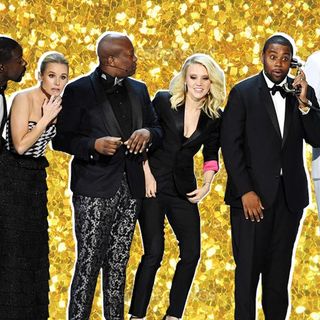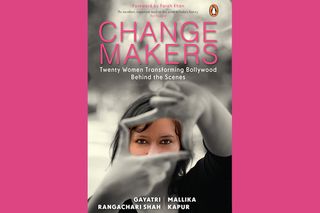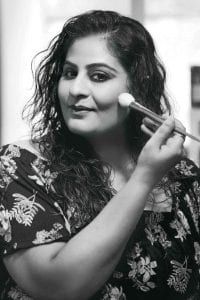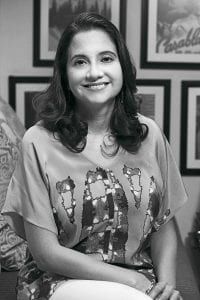
Meet The Women Disrupting Bollywood
A make-up artist, a stunt woman, and a film critic expose the reality behind the glam.

This book is about women in Bollywood. But it is not about those in the public gaze. The lives and loves, films and careers of actors are well chronicled. What about those women who work away from the limelight, behind the scenes of the Hindi film industry? You have most likely seen their work but often don’t know it. And you probably aren’t familiar with their names. They belong to a Bollywood we know little about.
Charu Khurana stood inside the Supreme Court of India. It was 14 November 2014. The crisp Delhi winter was just setting in. There was a nip in the air, but Charu was hot and out of breath. She had driven herself to Tilak Marg in her silver Maruti Esteem, waited in a slow-moving queue before climbing seventy steep steps to reach the courtroom.

Charu Khurana (Credit: Vijay Bedi)
Her back was sore and she was thirsty. She was six months pregnant. But there was no time to think about any of that. Standing under the whirring fans, she held her breath as Justice Dipak Misra read out his verdict in Charu Khurana v. The Union of India and Others. Unaware she was about to witness a watershed moment for women in India, Charu inhaled deeply. It was the culmination of a long journey—one that began many years earlier with a box of colourful, sparkling items.
In the Khurana household in New Delhi, that plain, beige box is a treasured family heirloom. Inside, a kaleidoscope of compartments hold an assortment of shiny bottles, pots of glitter and colourful plastic tubes. It is a vanity case that used to belong to Neelam Khurana, a former beautician, who passed it on to her daughter, Charu. Every now and then, Charu opens it and inhales a whiff of nostalgia. It is packed with memories of a happy, contented childhood, much of it spent playing with this box.
‘There were little bottles of Christian Dior, Estee Lauder, Chanel!’ the thirty-five-year-old exclaims. None of these brands were available in the pre-liberalization domestic Indian market in the 1980s. The contents of the box, out of reach for most people in the country, were prized valuables. A young Charu found them mesmerizing.
Charu is a celebrated make-up artist, admired for her creativity, respected for her grit. She has worked on some of India’s biggest films and with the country’s leading actors, including Kamal Haasan, Abhishek Bachchan and Anushka Shetty. Her background is in the razzle-dazzle world of films and commercials—who doesn’t remember the pointy-eared, double-horned monster in the iconic Onida ad with the ‘neighbour’s envy, owner’s pride’ tag line? Or Mani Ratnam’s Raavan and S.S. Rajamouli’s Baahubali? That’s Charu’s work. But her skill often takes her beyond big-ticket films and entertainment. When CNN required a make-up artist for the network’s interviews with Prime Minister Narendra Modi and with US President Barack Obama during his visit to New Delhi, it hired Charu. When the legendary editor Tina Brown brought her power-packed ‘Women in the World Summit’ to Asia for the first time, she chose Charu to be the make-up artist at the event.
Why Charu?
Perhaps it is because the girl who dreamed of a career as a make-up artist also unwittingly became something else—a crusader for gender equality in her country. Sitting on a couch in her living room in Delhi’s Lajpat Nagar early one morning, Charu remains focused even as her son climbs all over her. She recounts her lengthy struggle to end a decades-long discriminatory practice that banned women from working as make-up artists in the movie industry, allegedly because men needed the jobs.
You read that right.
Till 2014, women in India were not allowed to work as make-up artists in films. Sexism was rampant. When Charu, an ordinary girl with an extraordinarily deep-seated sense of justice, was denied work, she took matters into her own hands. After a lengthy battle, women were given the right to do make-up in the movies, because Charu decided to put up a hell of a fight for it.
Does a film journalist have the best job in the world? After all, what’s not to love about watching movies and then sharing your opinion on them? Anupama Chopra wouldn’t disagree. ‘Yes, there’s glamour. You get to meet stars, attend film premieres and go to world-class movie festivals. It seems so . . . seductive.’ However, there is a flip side. A.O. Scott, New York Times film critic whom Anu admires, writes in his 2016 book, Better Living Through Criticism: ‘People think of critics as failed artists, unloading long-simmering, envious resentments on those who had the luck, talent, or discipline to succeed. This assumption is so widespread as to amount to an article of public faith. Every working critic could easily assemble, from discarded letters and deleted emails, a suite of variations on the themes of “You’re just jealous” and “I’d like to see you do better”.’

Anupama Chopra (Credit: Vijay Bedi)
Anu is familiar with these jibes. On 6 August 2017, she tweeted the following about superstar Shah Rukh Khan’s highly publicized film Jab Harry Met Sejal (JHMS): ‘I love Hindi cinema so much, I take it personally. When a film doesn’t deliver it’s a personal let-down. Sadness lingers for days. #JHMS’
The reactions poured in thick and fast. Some said she was ‘writing crap’, others called her ‘cynical’. Unfortunately, being at the receiving end is part of the job, especially when she dares to speak her mind about revered celebrities with huge fan followings. ‘It’s hard, yes, and there are people who just don’t speak to you any more or get very upset,’ says Anu, seated in her Film Companion office in Bandra, which is decorated with vintage film posters. ‘I have massive affection for SRK but I did not like When Harry Met Sejal. I think he’s hurt by the response the film got and by the critics’ reviews, including mine. I can’t be a film critic or reviewer if I am dishonest in any way.’
Bollywood trade analyst Komal Nahta, who has known Anu since she was a rookie reporter for India Today, describes her as a diligent journalist. ‘She would not put down the phone till she got the information she wanted,’ he says. ‘I’ll take five minutes, I’ll take ten minutes, she would say. If it was a business story, she would say wait, wait, you have to go slow because I am not a Bollywood business person, so you’ll have to explain it to me.’ This is a trait that distinguished her from her peers.
The veteran journalist Madhu Jain, who was once Anu’s boss at India Today, says she has seldom come across anyone so passionate about movies. ‘I left the entire coverage of Indian cinema to her,’ Jain says. ‘With her quick intelligence and lucid style of writing, Anupama could have written about anything while she was in India Today, but it was only cinema that interested her—despite the fact that cinema was sneered at as soft, “back of the book” stuff—and it certainly was not the shortest ladder to the top of the hierarchy. But Anu was not interested in clambering up that ladder.’
Geeta Tandon sits on the floor of her modest one-room home in Malad, a working-class suburb in north Mumbai. Morning light streams in through a large window, creating shadows on the bare pink walls. Geeta rubs her calf vigorously. Still sore, she is massaging an injury she endured while riding a horse without a saddle and boots.

Geeta Tandon (Credit: Vijay Bedi)
Geeta, India’s foremost female Bollywood stunt artist and body double, isn’t afraid of getting hurt. She is used to it. Her suffering started well before she embarked on her career and her body is testament to that. From stitch marks on her hairline to bruises on her feet, scar after scar tells a story—of injury, of accidents, of falls. Those are the ones you can see. Other, deeper wounds remain concealed. But this ‘daredevil’ as the local media calls the thirty-four-year-old, wears her wounds like a badge of honour. ‘There is gain in pain,’ she says.
The aroma of Maggi noodles and sweet, steaming masala chai fills her home. She is tired after filming a horse-riding sequence the previous night for a Hindi television serial Chandra Nandini, a period drama based on the life of Chandragupta Maurya. Tandon has never learned horse riding or taken a martial arts course. Yet, she wields a sword, brandishes a revolver, drives cars through hoops of fire, chases bad guys on bikes, crashes through glass, jumps off rooftops—and yes, rides horses. Every skill she has acquired, she has learned on the job.
‘Do I feel scared? Everyone feels scared,’ she laughs. ‘But because I do this, I can run my house.’
While stunt artists usually remain invisible, lost behind the larger- than-life personae of the stars they fill in for, Geeta is one of the few women to make a name for herself through her work in commercial films. The cool stunts Deepika Padukone pulled off in Chennai Express? That’s Geeta. The scene in which Kareena Kapoor falls off a bike in Udta Punjab? Geeta again. The thrilling car chase in the Aishwarya Rai starrer Jazba? That was Geeta too.
Stunt work is an unusual choice for an Indian woman. Of the 581 stunt artists registered with the Movie Stunt Artist Association (MSAA) in Mumbai, only twelve are women, according to Aejaz Gulab, the group’s general secretary. Geeta is one of them. ‘She’s got guts,’ Gulab says. She’s also got one hell of a story about how she landed on a film set.
This is an edited extract from Changemakers : Twenty Women Transforming Bollywood Behind The Scenes by Gayatri Rangachari Shah and Mallika Kapur, available now through Penguin Random House India.
Gayatri Rangachari Shah is a journalist and columnist whose work has appeared in the New York Times and The Hindu. She is a contributing editor at Vogue and Architectural Digest and India head at Tina Brown Live Media. Gayatri covers a variety of subjects, including culture, gender, design and education, and has profiled leading personalities around the world. Mallika Kapur is an international news journalist, currently a senior editor at Bloomberg Live, aPaC. In her twenty-year career she has been a producer, anchor and correspondent for CNN in London, Mumbai and Hong Kong. She has reported extensively on key economic, political, social and gender issues in India and covered some of Asia’s biggest breaking news stories for the network.
Related


2017 Was the Most Miserable Year in a Decade, Says a Global Poll
